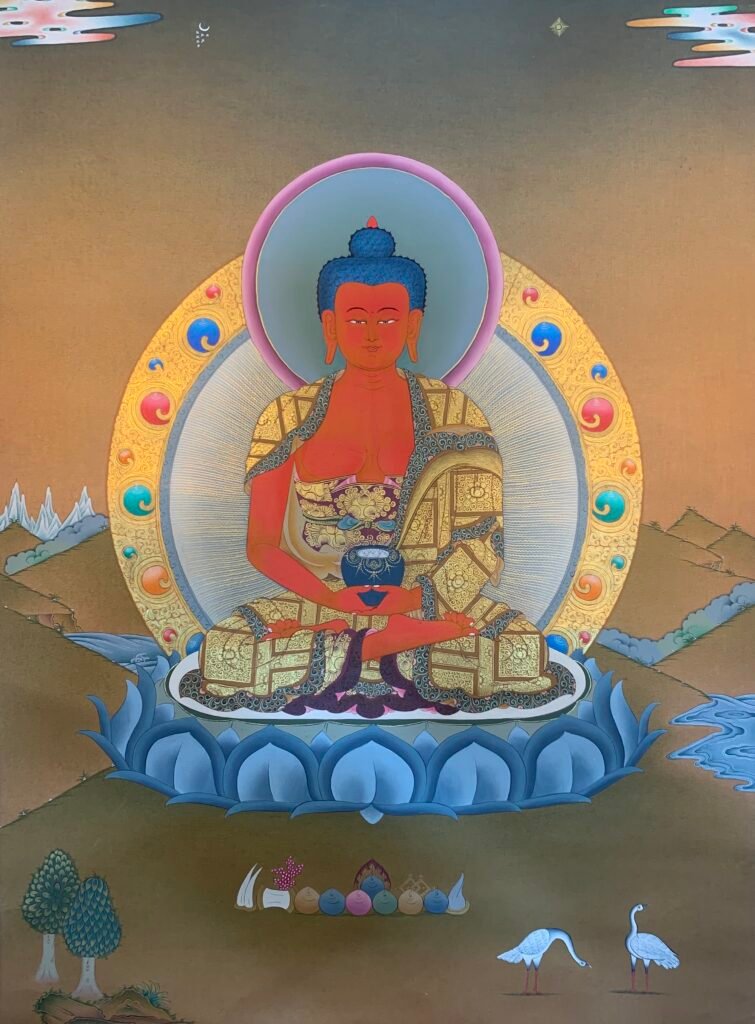Amitabha (Unlimited Light) thangka painting and Amitayus (Unlimited Life Span)
Amitabha (Unlimited Light) thangka painting and Amitayus (Unlimited Life Span) thangka painting are alternate names for the same Buddha. Chinese A-mi-t’0 and Japanese Amida are rendered from the short form, Amita. The cult of this Buddha dates back at least to 100 C.E.
Although the origin legends of the comic bodhisattvas are vague and subject to conflicting versions, the Amitabha legend is specific, furnished with history-like detail, and unified. Successive translations of the Sukhavati-vyuha Sutra, and a related surviving late Sanskrit text, reveal-in spite of significant variations- a consistent pattern of development. The later the version, the more Amitabha is glorified over Sakyamuni, and the fewer the restrictions on his power.
The spiritual development of Amita thangka (Amitbha Buddha) painting begins with a bhiksu named Dharmakra, who countless aeons ago heard a sermon from the Buddha Lokesvararaja and expressed a fervent desire to be come a Buddha like him. He implored the Buddha to teach him the way to supreme perfect Awakening and the qualities of a pure Buddha-field. The Tathagata then taught him the excellences and amenities of innumerable Buddha-lands for ten million years. Dharmakara took these good qualities, concentrated them all in one Buddha-land, Sukhavati, the Land of Bliss.
Amitabha Buddha using as a Dharmakara

In his Buddha-land, said Dharmakara, there would be no evil destinies (hell, animal, goest). There would be only a nominal difference between human beings and gods. All beings born there would almost, but not quite, be arhants destined for nirvana. Unless their bodhisattva vows bound them to further rebirths, they would be reborn only once. Nevertheless, their life span in Sukhavati would be unlimited. Evil would not be known there even by name. All beings would be able automatically automatically to hear whatever Dharma-theme they wished, yet there would be neither teaching nor learning because all would be capable of direct cognition and would be able to recite the Dharma informed by omniscience.
Amitabha Buddha is using as Buddha-land
The most crucial question concerning a (Amitbha Buddha) Buddha-land is how to attain rebirth there. Dharmakara’s vows provide a specific answer, although different versions of the Sukhavati-vyuha Sutra vary somewhat. In the (fifth-century?) Chinese version adopted as orthodox by the Chinese and Japanese Pure Land sects. Amida’s 18th vows states that all living beings in the 10 directions who with sincere faith desire rebirth in his land will attain it by calling this desire to mind only 10 times. Only those who have committed atrocities or slandered the True Dharma are excluded.
In Buddhism fallow Amitabha Buddha to be Pure land.
Although the (Amitbha Buddha)Pure Land doctrine that developed around this Sutra can be characterized as one of salvation by faith, the actual conditions for salvation specified in these vows qualify as a doctrine of fath and works. Salvation is not affected by Amita’s power alone. The candidate must also make an effort by living a virtuous life. From the point of view of earlier Buddhism, however, it is obvious that the work requirements for rebirth in this stream winner land have been considerably relaxed from what they were in the sutra pitaka. Wisdom, in particular, is conspicuous by its absence.
Having proclaimed his vows, (Amitbha Buddha) Dharmakara practiced the bodhisattva course for a trillion years until finally, 10 years ago, he became the Tathagata Amitabha presiding over the world-realm Sukhavati a trillion Buddha-fields away to the west, a realm endowed with all the virtues he had vowed that it would have.
In India, Amitabaha never became as popular as Sakyamuni. He is not very frequently represented in Indian art. Chinese pilgrims in the seventh century however, reported that the worship of Amitabha was widespread in India. In the Lotus Sutra and in Tantrism, Amitabha figures as one of the Five Tathagatas who rule the four cardinal points and the center, but there is no separate Amitabha sect in Tibet. The Far East was where the Buddha of the Western paradise become a dominant focus of reverence.

